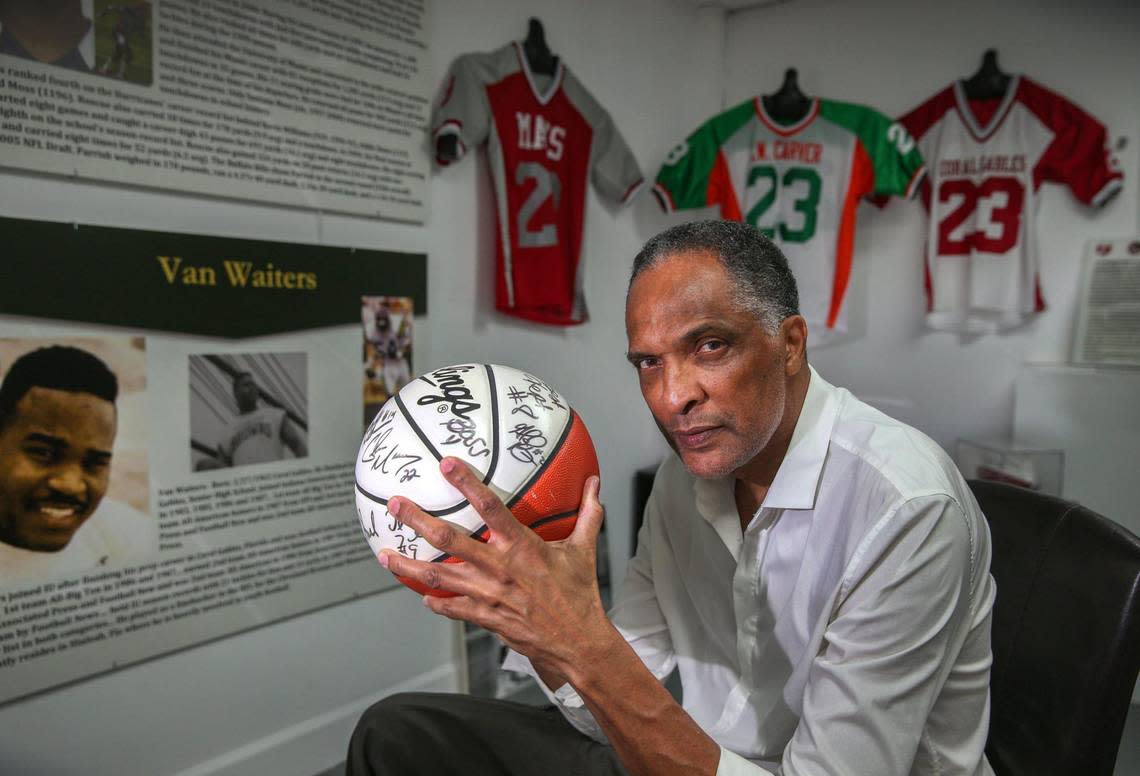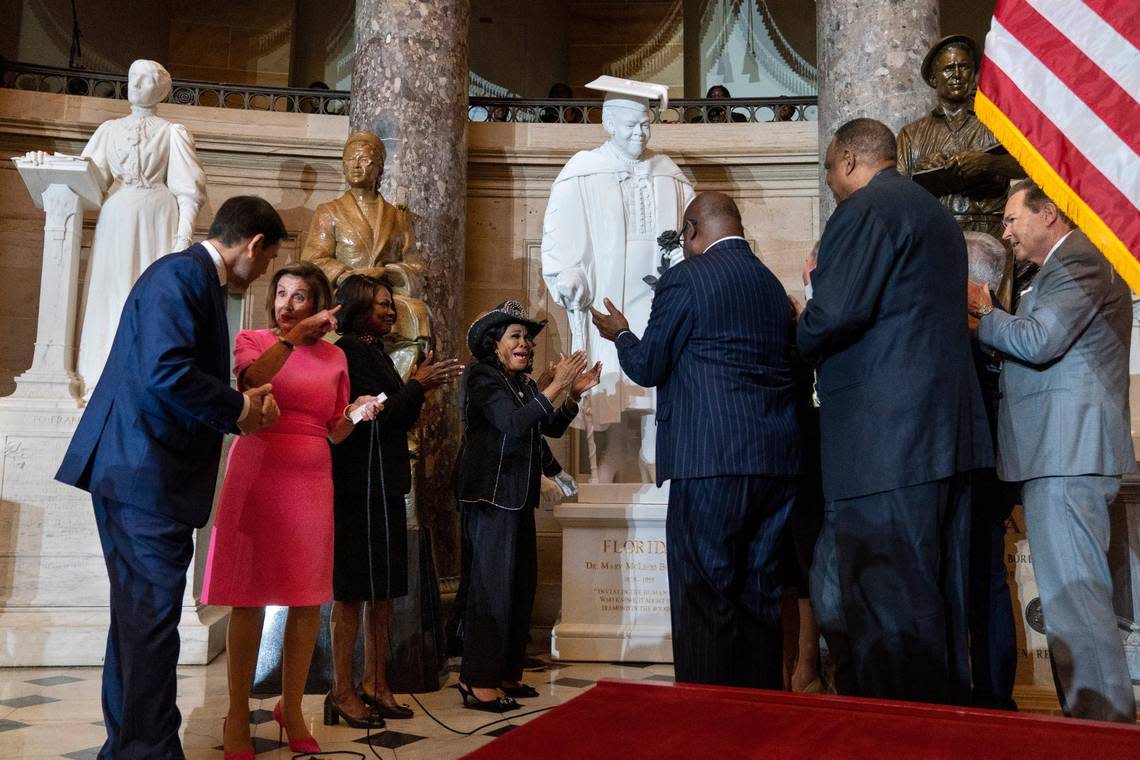The 44 Percent: statues, investigation of CBP agents in Del Rio & Quinta Brunson
Did you know about the statues in the U.S. Capitol? Here’s how they got there.
In 1864, the United States began collecting statues. The idea was simple: states would choose two historical figures to be enshrined in the U.S. Capitol for perpetuity. A section from the provision that created National Statuary Hall offered the following description:
Two deceased persons who have been citizens thereof, and illustrious for their historic renown or for distinguished civic or military services such as each State may deem to be worthy of this national commemoration.
Included in the gallery are sculptures of Chief Standing Bear (Nebraska), Helen Keller (Alabama), Jefferson Davis (Mississippi), Ronald Reagan (California) and many others.
For nearly a century, Confederate Gen. Edmund Kirby Smith represented Florida in the U.S. Capitol. Smith, as U.S. House Speaker Nancy Pelosi put it, was a “little known Confederate general” whose career highlights include graduating from West Point, fighting in the Mexican-American War and against Native Americans on the frontier, being wounded at the First Battle of Bull Run and commanding the Trans-Mississippi Department.

And just why was Smith’s statue removed? Only after the nationwide backlash following the 2015 slaughter of nine Black worshippers at a church in Charleston, S.C., did Florida legislators decide to take down Smith’s statue. It was replaced by one of Mary McLeod Bethune on Wednesday (more on that later) and made history: not one Black person was represented in the hall for most of its existence.
It is here where the words of Simon John, a medieval history expert, becomes relevant. In a 2019 History Today article about the significance of statues, John wrote that although monuments can help teach generations about the past, their meaning can be fluid.
“They are symbolic of the fixed ideas of a specific community regarding its past, as captured at a particular point in time,” he added.
John’s point raises several questions: what was Florida trying to convey with its Smith statue when the Confederate general’s likeness went up in 1922? Why did it stay untouched for roughly 100 years?
INSIDE THE 305

West Coconut Grove losing Black heritage. Stalwarts persist to build on 130-year legacy:
As Coconut Grove becomes more and more gentrified, many are still fighting to preserve the historically Black West Grove.
The examples are everywhere: the revitalization of the ACE Theater, a former segregated theater that recently received national historic designation; the Coconut Grove Sports Hall of Fame, a museum dedicated to the athletic accomplishments of natives; and Rebuilding Together Miami-Dade, a nonprofit that provides financial assistance to help locals keep their homes.
“Our goal is to keep people in the community, to keep the old guard here,“ said Ashley Snow, Rebuilding Together development director.
If you’re in need of a little Grove history (I, for one, had no idea that Frank Gore was from the Grove), this story is definitely for you.
OUTSIDE THE 305

Four border agents face discipline over ‘dangerous’ horseback behavior in Del Rio:
About 10 months after images of U.S. Customs and Border Protection agents seemingly using reins to whip at Haitian migrants in Del Rio, Texas, sparked widespread criticism of American immigration policy, the agency found “no evidence that agents struck any person with horse reins,” according to a report released Friday.
The investigation did discover “multiple instances in which Agents acted inappropriately during the incident.” Four agents could be reprimanded as part of a disciplinary process that is still underway.
Some Haitian leaders, however, dispute the report’s findings, with Haitian Bridge Alliance co-founder Guerline Jozef calling them “one-side.”
Jozef told the Miami Herald that until anti-Blackness in the immigration and border enforcement system is addressed, “we will continue to see more systematic abuse of Black migrants with impunity, like we saw in Del Río.”
“They must prioritize justice for the victims just as much as they’ve prioritized protections for their own — the perpetrators — and [we] will continue to fight for this justice with our lawsuit,” she said.

Black female support groups grapple with end of Roe:
Self-care is always important — even more so during difficult times.
A recent Washington Post story detailed the importance of support groups for Black women following the overturning of Roe v. Wade. As The Post’s Natachi Onwuamaegbu writes, these groups, which were originally created to fill the void in Black health care, have become even more crucial in a post-Roe world.
In recent years, new and older groups have had to adapt to support their members through moments of national trauma that tend to unevenly affect Black women and their communities. The Dobbs decision is the latest example: Experts say that restricted access to abortion will disproportionately impact Black women, who have a higher rate of abortion than their White counterparts. Reproductive-rights organizations say the reasons for these higher rates are systemic, driven by a lack of access to and effective use of contraceptives.

History-making statue of Mary Bethune now stands tall for Florida in U.S. Capitol:
Daughter of enslaved people. Founder of Bethune-Cookman University. Orchestrator of the Black Cabinet.
Mary McLeod Bethune deserves no introduction. Generations to come will now know her name as her 11-foot marble likeness was placed in the U.S. Capitol, making her the first Black person to be enshrined in the collection.
“Our hearts are rejoicing today, seeing our founder and namesake take her rightful place among the most distinguished Americans here in the center of our democracy,” Bethune-Cookman Interim President Lawrence Drake II said during the unveiling ceremony.
“No one could have predicted that this daughter of slaves would create a university, found a powerful political organization, advise presidents and inspire generations,” Drake continued. “Through her hopeful vision, her hard work, her generous spirit, and her deep, deep faith, she made a lasting and positive mark on our country and the world.”
Prior to Bethune, former Confederate Gen. Edmund Kirby Smith and John Gorrie, often credited as the father of air condition, represented Florida. Smith’s statue was removed last September.
HIGH CULTURE

Quinta Brunson makes Emmy history:
“He. Got. Money.”
In just there words, Quinta Brunson became a hit sensation on Vine. Now, she just made Emmy history, becoming the first Black woman to receive three comedy nominations for her critically acclaimed sitcom “Abbott Elementary.”
The three nominations — outstanding comedy series, lead actress in a comedy and writing for a comedy series — all by the age of 32 also make Brunson the youngest Black woman to earn comedy acting nominations.
If you haven’t watched “Abbott Elementary,” go do yourself a favor and catch up. All 13 episodes are available now via Hulu.
Where does “The 44 Percent” name come from? Click here to find out how Miami history influenced the newsletter’s title.
